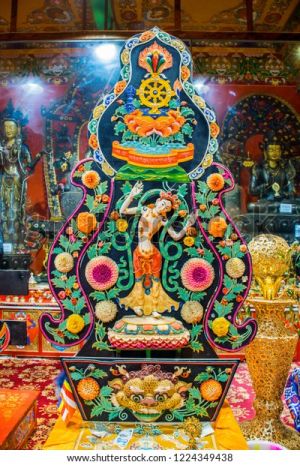Torma in the Tibetan Renaissance Period
Torma
Torma (gtor ma) are Tibetan ritual cakes used as offerings in Buddhist and Bon rites. Ritualized food offerings in Tibet likely had their origins in India, where food offerings called bali were an integral part of puja rites. Bali included many foodstuffs both raw and prepared, yet when this custom entered
fresh-food scare Tibet the offering was made from the ever present barley grain (tsampa) and yak butter. Barley was already in use in Tibet in Bon ritual contexts, and the origins of torma in particular are claimed by both the Buddhist and the Bon traditions.
Torma are made by both monastics and laity. With clean hands, the flour and butter are shaped in a tower of sorts, sometimes directly mimicking the shape of a stupa, or the silhouette of a Buddha depiction, or the
shape of Mount Meru. This original shape may have come about from the tradition of making stone heaps or cairns. The torma is covered with a coat of melted butter which is sometimes colored. It may then be decorated with flowers, precious stones, and other auspicious objects.
Shapes and the process of making torma became more complex as tantric rituals in Tibet complexified, and the color, shape, size of torma is determined by its purpose. White torma are generally associated with
Tara and Avalokiteshvara, and red torma with wrathful deities such as Yamantaka and Hayagriya. Torma are sometimes elaborately decorated with a pantheon of symbols steeped in spiritual significance, such as a bell, which symbolizes wisdom.
The Tibetan word ‘torma’ has come to indicate not only ritual food cakes, but also indicates the Buddhist concepts of selflessness, impermanence and the Bodhisattva path. The act of making torma is considered to have spiritual, mind-purifying benefits.
Torma have many ritual functions. Torma offerings include codified rituals with particular mantras, meditation, mudras, and songs, and are often offered to the Buddha or Bodhisattvas. Torma are also used in rituals intending to produce practical results, such as a healing, exorcism, or rites for increased wealth.
These torma are either broken up and scattered after the ritual (mchod pa bul ba) or consumed by the participants (dnos sgrub). Another type of torma is used in deity meditation, in which the torma is perceived either as the deity or the deity’s dwelling place.
Torma in the Tibetan Renaissance Period
No references to “torma” or “cake” were found in the Blue Annals, yet other Renaissance period sources mention the use of ritual torma. A story is told about the eleventh century teacher Zurpoche in which daily torma offerings are mentioned. Also, the hagiography of the eleventh-century monk Dzeng tells of selling
bits of cloth in order to buy torma and food. Clearly torma were used ritually in Renaissance Tibet and were also valued as highly as food for sustenance. Exactly when the use of ritual cakes began in Tibet is unclear, and a topic for future research.
Bibliography
Butler, Claudia. “Torma: the Tibetan Ritual Cake.” Cho-yang. No.7 (1996): 38-52.
Dudjom Rinpoche, The Nyingma School of Tibetan Buddhism: Its Fundamentals and History. (Boston: Wisdom Publications, 1991). The volume is the source of the two Renaissnace period references to torma and is cited by Matthew Kapstein in The Tibetans.
Kapstein, Matthew. The Tibetans. Malden, MA: Blackwell Press (2006).
Kohn, Richard J. “An Offering of Torma.” Religions of Tibet in Practice, Lopez, Donald S., Jr., ed. Princeton: Princeton University Press (1997): 255-265.
Tibetan Himalayan Digital Library
Source
[[1]]
